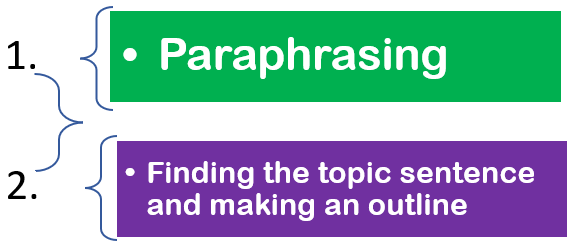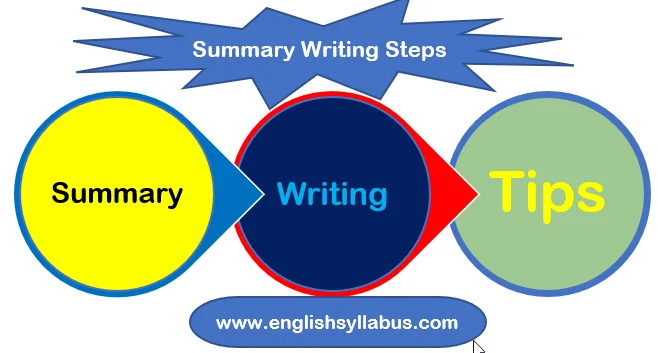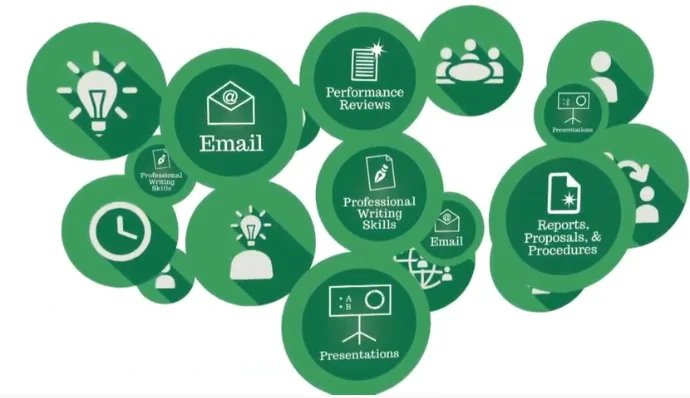Time needed: 15 minutes
Summary writing is a shortened or condensed version of an original text or passage. Writing a summary in your own words requires skills how to restate briefly and concisely. We need to summarise the primary points and important supporting details and evidence. So, we reduce the content to its most basic components. For this purpose, we merely reflect on what the writer has said, without passing judgment on it. Because our aim is to share the main ideas by omitting irrelevant information. Always maintain the tone of the original piece by avoiding opinions and reported speeches. Simply, use the present tense when you’re writing your summary. Just filter out information from your general passage and skip:
– examples
– supporting details
– Detailed lists
– comparisons
– contrasts
This is an easygoing process to focus on the main points from the extended passage when you start summary writing. Lastly, Follow the Steps below to write a summary.
- Identify Main Ideas
Read the original text thoroughly and identify topic sentences or headings. Look for repeated concepts, themes, or phrases and the purpose of the author. Scanning will help you to find out the main ideas.

- Recognize supporting details
Determine the relationship between the arguments and the supporting details. Look for evidence, examples, facts, statistics, and personal experiences used to support the argument. Skimming will help you to find out the supporting details.

- Take Brief Notes
Write down a few notes to help you remember the main ideas and supporting details. Create an outline or concept map of the text structure. Use abbreviations, symbols, and keywords to take brief notes on the text. Take note of the author’s tone, style, and language to identify any digressions or distractions. Focus on the most important information and avoid copying whole sentences.

- Skip Irrelevant Details
Delete any irrelevant information and condense your notes into a few sentences that capture the core of the original text. Overlook repetitions or information that is not directly related to the main idea. Evaluate the importance of each piece of information in relation to the main idea. Use highlighting, underlining, or marking to indicate important information.

- Restate in your own Words
Use your own words to condense the information into a few sentences. Then write a summary that captures the essence of the text. For this, write a brief introduction that sets the context and gives an overview of the text. But, avoid using direct quotes and instead paraphrase the information using your own language.

- Review for Clarity
Check the summary for accuracy, clarity, and conciseness. If you want to ensure that the summary is concise and to the point, focus on the most important information. So, review it to exclude minor details, opinions, repetitions, examples, and other unnecessary details. You can also group similar information together and use headings or subheadings.

- Revise for Editing
Revise and edit as needed. Lastly, proofread and edit your summary for grammar, spelling, and punctuation errors. Overall, keep the focus on the main idea and key arguments while editing.

Scan to Locate Main Ideas
- Read the text thoroughly and understand the purpose of the author.
- Look for repeated concepts, themes, or phrases.
- Identify topic sentences or headings.
- Observe any connections between paragraphs.
- Check the introduction and conclusion of the text.
- Highlight or underline key points.
- Ask questions about the text and try to answer them.
- Draw a concept map or create an outline of the text.
- Use your understanding of the text to condense the information into a few key points.
Skim for Supporting Details
- Read the text carefully and determine the purpose of the author.
- Identify the main argument or claim made in the text.
- Look for evidence, examples, facts, statistics, and personal experiences used to support the argument.
- Determine the relationship between the argument and the supporting details.
- Observe the author’s tone and language to see how they present their argument and support it.
- Check for any counterarguments or objections and how the author responds to them.
- Highlight or underline the key arguments and supporting details.
- Ensure that the summary accurately reflects the argument and supporting details using your own words.
Key Skills required in Summary Writing
- To Differentiate between a topic sentence (main idea) and supporting Details.
- To identify the most relevant vs least relevant information.
- Write the summary in your own words but without mixing up information with your opinions.
- After you finish reading, write a few sentences in your own words about what is important in the text.
- Make it understandable without quoting the original sentences or passages from the text.
- Underline each major support point. This support may be a sentence or a group of sentences.
- Remember to double-underline the main point and write them in the margin next to them.
- Next, underline the final observations, recommendations, or conclusions, and write “conclusion” in the margin.
- Finally, make it a readable unified whole with coherence and cohesion.
Paraphrasing
To paraphrase means completely expressing other people’s ideas in one’s own words in the correct form. First, you read the actual passage thoroughly and understand its meaning entirely. Then consider the original article as a whole, not in isolated sentences.
 |
Final Suggestions
- Start with reading the instructions given above your passage because they guide you on how long your summary ought to be. And what you’re being asked to summarize.
- Spend a few moments to twice read the original text. Understand the meaning of difficult words in the context while reading. Then figure out what is the overall text about seeing the big picture as presented in the passage.
- Scan the passage to see which keywords or phrases appear most often. Because this is likely to be the main topic of the passage.
- Avoid irrelevant information by excluding minor details, opinions, repetitions, examples, dialogues or quotations, and statistical data.
- Write in complete prose form using transition words (Conjunctions) Because transitions flow your summary smoothly while reading it.
- Lastly, the final version should read like a whole sensible piece of writing.
- Always remember to edit and check your spelling and grammar mistakes.








